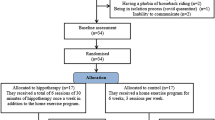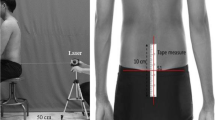Abstract
Background
In older adults, musculoskeletal pain is associated with increased concerns of falling, reduced balance and increased occurrence of falls. In younger adults, the intensity of neck pain and low back pain is associated with increased postural sway. It is not known if pain further impairs balance and concerns of falling in mobility-limited older adults, and if so, whether this is associated with different intensities of pain.
Objective
This study examined whether mobility-limited older adults with mild or intense neck pain and/or low back pain have significantly increased postural sway as measured by centre of pressure (COP) changes and concerns of falling compared to those without pain.
Methods
48 older adults with a gait speed of < 0.9 m/s from Odense, Denmark were recruited through the public health service. Self-reported neck pain, low back pain, and concerns of falling were recorded on questionnaires. Sway range, velocity and area were recorded on a force plate in a comfortable standing stance. Pain intensity was rated on an 11 point numerical rating scale (0–10). Participants were sub-grouped into mild (0–4) and intense (> 5) neck pain or low back pain.
Results
Intense neck pain was associated with increased anterior-posterior sway range and area of sway. Intense low back pain was associated with increased concerns of falling.
Conclusion
Intense neck pain in mobility-limited older adults is associated with significant changes in postural balance, and intense low back pain is associated with significantly higher concerns of falling.


Similar content being viewed by others
References
Shimada H, Suzukawa M, Tiedemann A et al (2009) Which neuromuscular or cognitive test is the optimal screening tool to predict falls in frail community-dwelling older people? Gerontology 55:532–538
Stubbs B, Eggermont LH, Patchay S et al (2014) Pain interference is associated with psychological concerns related to falls in community-dwelling older adults: multisite observational study. Phys Ther 94:1410–1420
Stubbs B, Schofield P, Patchay S et al (2016) Musculoskeletal pain characteristics associated with lower balance confidence in community-dwelling older adults. Physiotherapy 102:152–158
Leveille SG, Jones RN, Kiely DK et al (2009) Chronic musculoskeletal pain and the occurrence of falls in an older population. JAMA 302:2214–2221
Piirtola M, Era P (2006) Force platform measurements as predictors of falls among older people—a review. Gerontology 52:1–16
Laughton CA, Slavin M, Katdare K et al (2003) Aging, muscle activity, and balance control: physiologic changes associated with balance impairment. Gait Posture 18:101–108
Melzer I, Kurz I, Oddsson LI (2010) A retrospective analysis of balance control parameters in elderly fallers and non-fallers. Clin Biomech (Bristol Avon) 25:984–988
del-Rio-Valeiras M, Gayoso-Diz P, Santos-Perez S et al (2016) Is there a relationship between short FES-I test scores and objective assessment of balance in the older people with age-induced instability? Arch Gerontol Geriatr 62:90–96
Ruhe A, Fejer R, Walker B (2013) On the relationship between pain intensity and postural sway in patients with non-specific neck pain. J Back Musculoskelet Rehabil 26:401–409
Ruhe A, Fejer R, Walker B (2011) Center of pressure excursion as a measure of balance performance in patients with non-specific low back pain compared to healthy controls: a systematic review of the literature. Eur Spine J 20:358–368
Hvid LG, Strotmeyer ES, Skjodt M et al (2016) Voluntary muscle activation improves with power training and is associated with changes in gait speed in mobility-limited older adults—a randomized controlled trial. Exp Gerontol 80:51–56
MacKenzie DM, Copp P, Shaw RJ et al (1996) Brief cognitive screening of the elderly: a comparison of the mini-mental state examination (MMSE), abbreviated mental test (AMT) and mental status questionnaire (MSQ). Psychol Med 26:427–430
Kahle-Wrobleski K, Corrada MM, Li B et al (2007) Sensitivity and specificity of the mini-mental state examination for identifying dementia in the oldest-old: the 90+ study. J Am Geriatr Soc 55:284–289
Dionne CE, Dunn KM, Croft PR et al (2008) A consensus approach toward the standardization of back pain definitions for use in prevalence studies. Spine 33:95–103
Delbaere K, Close JC, Mikolaizak AS et al (2010) The falls efficacy scale International (FES-I). A comprehensive longitudinal validation study. Age Ageing 39:210–216
Doyle RJ, Hsiao-Wecksler ET, Ragan BG et al (2007) Generalizability of center of pressure measures of quiet standing. Gait Posture 25:166–171
Vuillerme N, Pinsault N (2009) Experimental neck muscle pain impairs standing balance in humans. Exp Brain Res 192:723–729
Madeleine P, Prietzel H, Svarrer H et al (2004) Quantitative posturography in altered sensory conditions: a way to assess balance instability in patients with chronic whiplash injury. Arch Phys Med Rehabil 85:432–438
Boudreau SA, Falla D (2014) Chronic neck pain alters muscle activation patterns to sudden movements. Exp Brain Res 232:2011–2020
Uthaikhup S, Jull G, Sungkarat S et al (2012) The influence of neck pain on sensorimotor function in the elderly. Arch Gerontol Geriatr 55:667–672
Liu JX, Thornell LE, Pedrosa-Domellof F (2003) Muscle spindles in the deep muscles of the human neck: a morphological and immunocytochemical study. J Histochem Cytochem 51:175–186
Deschamps T, Beauchet O, Annweiler C et al (2014) Postural control and cognitive decline in older adults: position versus velocity implicit motor strategy. Gait Posture 39:628–630
Richardson K, Bennett K, Kenny RA (2015) Polypharmacy including falls risk-increasing medications and subsequent falls in community-dwelling middle-aged and older adults. Age Ageing 44:90–96
Ekvall Hansson E, Magnusson M (2013) Vestibular asymmetry predicts falls among elderly patients with multi-sensory dizziness. BMC Geriatr 13:77
Karttunen N, Lihavainen K, Sipila S et al (2012) Musculoskeletal pain and use of analgesics in relation to mobility limitation among community-dwelling persons aged 75 years and older. Eur J Pain (London England) 16:140–149
Menant JC, Wong A, Sturnieks DL et al (2013) Pain and anxiety mediate the relationship between dizziness and falls in older people. J Am Geriatr Soc 61:423–428
Author information
Authors and Affiliations
Corresponding author
Ethics declarations
Conflict of interest
All authors declare they do not have any conflict of interest.
Funding
This work was supported by an international stipend from the Foundation for Chiropractic Research and Postgraduate Education (Denmark) (Grant No. 14/603). The HANC study is supported by the European funding program INTERREG Iva (Grant No. 11/23147). Neither funding source had any involvement in: study design; in the collection, analysis and interpretation of data; in the writing of the report; or in the decision to submit the article for publication.
Statement of human and animal rights
This trial was part of the Healthy Ageing Network of Competence (HANC) study (Clinical trial registration NCT02051725) and obtained ethics approval from the Regional Scientific Ethical Committees for Southern Denmark (approval S-20120149)
Informed consent
All participants gave informed consent as part of the HANC study.
Rights and permissions
About this article
Cite this article
Kendall, J.C., Hvid, L.G., Hartvigsen, J. et al. Impact of musculoskeletal pain on balance and concerns of falling in mobility-limited, community-dwelling Danes over 75 years of age: a cross-sectional study. Aging Clin Exp Res 30, 969–975 (2018). https://doi.org/10.1007/s40520-017-0876-7
Received:
Accepted:
Published:
Issue Date:
DOI: https://doi.org/10.1007/s40520-017-0876-7




